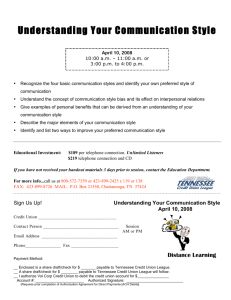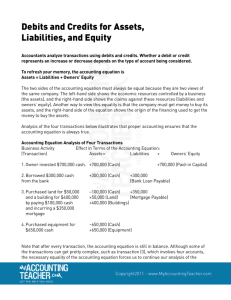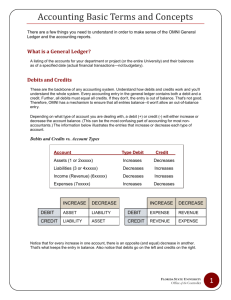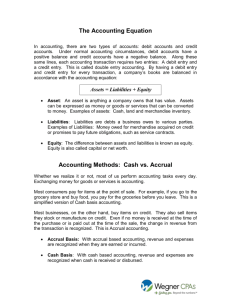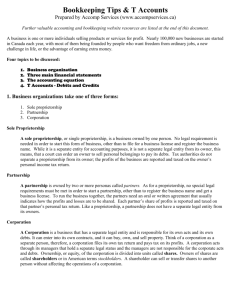Learning Goal 22: “Debits on the left, credits on the right!”
advertisement
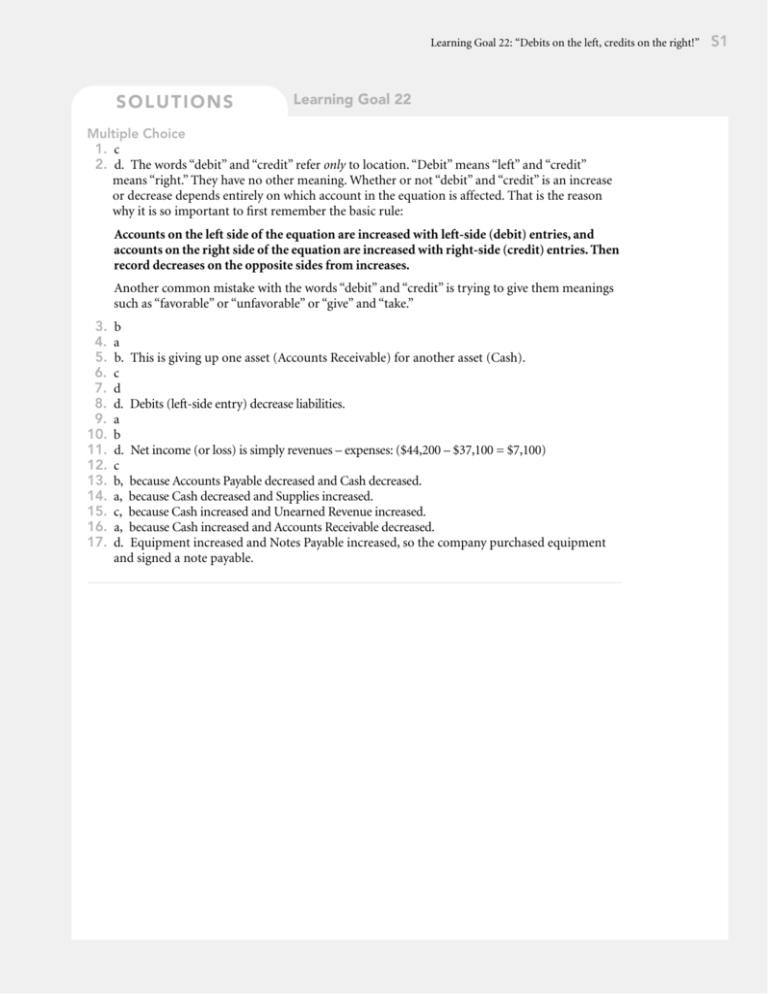
Learning Goal 22: “Debits on the left, credits on the right!” SOLUTIONS Learning Goal 22 Multiple Choice 1. c 2. d. The words “debit” and “credit” refer only to location. “Debit” means “left” and “credit” means “right.” They have no other meaning. Whether or not “debit” and “credit” is an increase or decrease depends entirely on which account in the equation is affected. That is the reason why it is so important to first remember the basic rule: Accounts on the left side of the equation are increased with left-side (debit) entries, and accounts on the right side of the equation are increased with right-side (credit) entries. Then record decreases on the opposite sides from increases. Another common mistake with the words “debit” and “credit” is trying to give them meanings such as “favorable” or “unfavorable” or “give” and “take.” 3. 4. 5. 6. 7. 8. 9. 10. 11. 12. 13. 14. 15. 16. 17. b a b. This is giving up one asset (Accounts Receivable) for another asset (Cash). c d d. Debits (left-side entry) decrease liabilities. a b d. Net income (or loss) is simply revenues – expenses: ($44,200 – $37,100 = $7,100) c b, because Accounts Payable decreased and Cash decreased. a, because Cash decreased and Supplies increased. c, because Cash increased and Unearned Revenue increased. a, because Cash increased and Accounts Receivable decreased. d. Equipment increased and Notes Payable increased, so the company purchased equipment and signed a note payable. S1 S2 Section V · Using a Basic Accounting System SO L U T ION S Learning Goal 22, continued Reinforcement Problems LG 22-1. Account Natural Positive Side Dr. Cr. ✓ a. Supplies b. Accounts Payable ✓ c. Service Revenue ✓ d. Cash ✓ e. R. Penland, Drawing ✓ f. R. Penland, Capital ✓ g. Accounts Receivable ✓ h. Rent Expense ✓ i. Prepaid Rent ✓ j. Equipment ✓ k. Unearned Revenue ✓ l. Notes Payable ✓ LG 22-2. a. . . . when a debit is to item on the left side of the equation (assets). b. . . . when a debit is to an item on the right side of the equation (liabilities and owner’s equity). (Note: expenses and withdrawals decrease owner’s equity, so expenses and withdrawals are recorded with debits.) c. . . . when a credit is to an item on the right side of the equation (liabilities and owner’s equity). d. . . . when a credit is to an item on the left side of the equation (assets). LG 22-3. Assets Liabilities Owner’s Capital Revenue Expense Drawing Debit Increase Decrease Decrease Decrease Increase Increase Credit Decrease Increase Increase Increase Decrease Decrease Dr. Cr. Cr. Cr. Dr. Dr. Natural Positive Balance? ∗ Note: Natural positive balances (“normal balances”) are always on the increase side. Learning Goal 22: “Debits on the left, credits on the right!” SOLUTIONS Learning Goal 22, continued LG 22-4. a. The word “debit” refers to location—specifically, left side—but not increase or decrease. “Debit” has nothing to do with knowing how to increase or decrease accounts. Knowing how to increase or decrease accounts is a completely separate rule. The word “debit” is only used after the rule is applied. b. The word “credit” refers to location—specifically, right side—but not increase or decrease. “Credit” has nothing to do with knowing how to increase or decrease accounts. Knowing how to increase or decrease accounts is a completely separate rule. The word “credit” is only used after the rule is applied. c. The rule for increasing and decreasing accounts is this: Any item on the left side of the accounting equation (assets) is increased with a left-side entry, and any item on the right side of the accounting equation (liabilities and owner’s equity) is increased with a right-side entry. To do decreases, just do the opposite of increases. The result: An asset is on the left side, so it is increased with a left-side entry, which we call a “debit.” We know that an expense is part of owner’s equity, and owner’s equity is on the right side of the equation, so owner’s equity should be increased with a right-side entry (which we call a “credit”). However, an expense is a decrease to owner’s equity, so we just do the opposite of an increase. We make a left-side entry, called a “debit.” As expenses increase, owner’s equity decreases. d. Do not think about “debits” or “credits” first. Apply the RULE FIRST! The rule is: Any item on the left side of the accounting equation (assets) is increased with a left-side entry, and any item on the right side of the accounting equation (liabilities and owner’s equity) is increased with a right-side entry. To do decreases, just do the opposite of increases. After you apply the rule, you can use the words “debit” and “credit.” LG 22-5. a. Essex Company receives $1,000 from a customer before the services are provided. Analysis: The asset Cash increases by $1,000. The liability Unearned Revenue increases by $1,000. Apply the rule: Assets are increased with debits: debit Cash $1,000. Liabilities are increased with credits: credit Unearned Revenue $1,000. Record in T account: Cash 1,000 Unearned Revenue 1,000 S3 S4 Section V · Using a Basic Accounting System SO L U T ION S Learning Goal 22, continued LG 22-5, continued b. Montgomery Enterprises receives a $200 electric bill. The bill is not paid immediately. Analysis: The expense Utility Expense increases by $200. The liability Accounts Payable increases by $200. Apply the rule: Expenses are increased with debits: debit Utility Expense $200. Liabilities are increased with credits: credit Accounts Payable $200. Record in T account: Utility Expense Accounts Payable 200 200 c. Prince Georges Company finishes consulting services for a client and sends the client a bill for $5,000. Analysis: The asset Accounts Receivable increases by $5,000. The revenue Fees Earned (or similar name, such as Service Revenue, etc.) increases by $5,000. Apply the rule: Assets are increased with debits: debit Accounts Receivable $5,000. Revenues are increased with credits: credit Fees Earned $5,000. Record in T account: Accounts Receivable 5,000 Fees Earned 5,000 d. Cecil Company prepays six months of fire insurance for $2,500. Analysis: The asset Prepaid Insurance increases by $2,500. The asset Cash decreases by $2,500. Apply the rule: Assets are increased with debits: debit Prepaid Insurance $2,500. Assets are decreased with credits: credit Cash $2,500. Record in T account: Prepaid Insurance 2,500 Cash 2,500 Learning Goal 22: “Debits on the left, credits on the right!” SOLUTIONS Learning Goal 22, continued LG 22-5, continued e. James Lafayette, owner of Anchorage Company, invests $9,000 in his business. Analysis: The asset Cash increases by $9,000. The owner’s equity James Lafayette, Capital increases by $9,000. Apply the rule: Assets are increased with debits: debit Cash $9,000. Owner’s equity is increased with credits: credit James Lafayette, Capital $9,000. Record in T account: Cash James Lafayette, Capital 9,000 9,000 f. Soldotna Company pays a $1,000 account payable. Analysis: The asset Cash decreases by $1,000. The liability Accounts Payable decreases by $1,000. Apply the rule: Assets are decreased with credits: credit Cash $1,000. Liabilities are decreased with debits: debit Accounts Payable $1,000. Record in T account: Cash 1,000 Accounts Payable 1,000 g. Nome Commercial Company purchases $10,000 of equipment, paying $3,000 cash and signing a note payable for the balance. Analysis: The asset Equipment increases by $10,000. The asset Cash decreases by $3,000. The liability Notes Payable increases by $7,000. Apply the rule: Assets are increased with debits: debit Equipment $10,000. Assets are decreased with credits: credit Cash $3,000. Liabilities are increased with credits: credit Notes Payable $7,000. Record in T account: Equipment 10,000 Cash 3,000 Notes Payable 7,000 S5 S6 Section V · Using a Basic Accounting System SO L U T ION S Learning Goal 22, continued LG 22-6. Accounts Receivable Cash (a) 12,000 (e) 2,000 (b) 5,500 (d) (e) 350 500 Equipment (c) 200 (j) 750 (h) 150 1,250 (g) (i) (j) Supplies (b) 5,500 50 5,500 200 800 750 (k) 1,000 (l) 250 6,350 Unearned Revenue Accounts Payable (c) 200 (f) 170 (g) Jack Davis, Drawing Jack Davis, Capital (a) 12,000 (l) 250 (m) 50 200 200 (k) 1,000 1,000 12,000 170 Teaching Revenue Utilities Expense (d) 350 (e) 2,500 (m) 50 Telephone Expense Supplies Expense Rent Expense (f) 100 (f) 70 (h) 150 (i) 800 100 70 150 800 2,900 Note: Account balances are always entered on the positive sides of the accounts. (k) (l) 1,200 Net Income: $5,900 (j) 11, 000 Land (b) 460 250 (n) 2,500 (o) 1,000 A (l) 1,200 (c) 4,500 Office Equipment 3,800 (d) 3,900 (h) 1,100 Accounts Receivable = (j) 8,500 910 (i) 190 (b) 460 (g) 510 Notes Payable (k) 250 Accounts Payable L (m) 2,000 (f) 5,000 3,000 Unearned Revenue + (i) 190 Telephone Expense 1,510 (g) 510 (o) 1,000 Advertising Expense (e) 2,400 Rent Expense (n) 2,500 A. Alvarez, Withdrawals OE 3,900 (h) 4,100 (m) 2,000 10,000 (d) Commission Revenue (a) 35,000 A. Alvarez, Capital SOLUTIONS Supplies 31,050 (j) (h) 3,000 2,500 (c) 4,500 (e) 2,400 (a) 35,000 (f) 5,000 Cash LG 22-7. Learning Goal 22: “Debits on the left, credits on the right!” Learning Goal 22, continued S7



